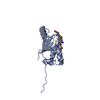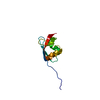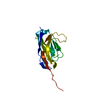[English] 日本語
 Yorodumi
Yorodumi- PDB-2kk8: NMR Solution Structure of a Putative Uncharacterized Protein obta... -
+ Open data
Open data
- Basic information
Basic information
| Entry | Database: PDB / ID: 2kk8 | ||||||
|---|---|---|---|---|---|---|---|
| Title | NMR Solution Structure of a Putative Uncharacterized Protein obtained from Arabidopsis thaliana: Northeast Structural Genomics Consortium target AR3449A | ||||||
 Components Components | Uncharacterized protein AT4g05270 | ||||||
 Keywords Keywords |  Structural Genomics / Unknown function / Structural Genomics / Unknown function /  Arabidopsis thaliana / AR3449A / uncharacterized putative protein / NESG / Arabidopsis thaliana / AR3449A / uncharacterized putative protein / NESG /  Protein Structure Initiative / Northeast Structural Genomics Consortium Protein Structure Initiative / Northeast Structural Genomics Consortium | ||||||
| Function / homology |  Function and homology information Function and homology information proteasome binding / polyubiquitin modification-dependent protein binding / proteasome binding / polyubiquitin modification-dependent protein binding /  ubiquitin binding / proteasome-mediated ubiquitin-dependent protein catabolic process / ubiquitin binding / proteasome-mediated ubiquitin-dependent protein catabolic process /  nucleoplasm / nucleoplasm /  cytosol cytosolSimilarity search - Function | ||||||
| Biological species |   Arabidopsis thaliana (thale cress) Arabidopsis thaliana (thale cress) | ||||||
| Method |  SOLUTION NMR / SOLUTION NMR /  simulated annealing simulated annealing | ||||||
| Model details | lowest energy, model 1 | ||||||
 Authors Authors | Mani, R. / Gurla, S.V.T. / Shastry, R. / Ciccosanti, C. / Foote, E. / Jiang, M. / Xiao, R. / Nair, R. / Everett, J. / Huang, Y. ...Mani, R. / Gurla, S.V.T. / Shastry, R. / Ciccosanti, C. / Foote, E. / Jiang, M. / Xiao, R. / Nair, R. / Everett, J. / Huang, Y. / Acton, T. / Rost, B. / Montelione, G.T. / Northeast Structural Genomics Consortium (NESG) | ||||||
 Citation Citation |  Journal: To be Published Journal: To be PublishedTitle: NMR Solution Structure of a Putative Uncharacterized Protein obtained from Arabidopsis thaliana: Northeast Structural Genomics Consortium Target AR3449A Authors: Mani, R. / Gurla, S.V.T. / Shastry, R. / Ciccosanti, C. / Foote, E. / Jiang, M. / Xiao, R. / Nair, R. / Everett, J. / Huang, Y. / Acton, T. / Rost, B. / Montelione, G.T. | ||||||
| History |
|
- Structure visualization
Structure visualization
| Structure viewer | Molecule:  Molmil Molmil Jmol/JSmol Jmol/JSmol |
|---|
- Downloads & links
Downloads & links
- Download
Download
| PDBx/mmCIF format |  2kk8.cif.gz 2kk8.cif.gz | 584.5 KB | Display |  PDBx/mmCIF format PDBx/mmCIF format |
|---|---|---|---|---|
| PDB format |  pdb2kk8.ent.gz pdb2kk8.ent.gz | 496.2 KB | Display |  PDB format PDB format |
| PDBx/mmJSON format |  2kk8.json.gz 2kk8.json.gz | Tree view |  PDBx/mmJSON format PDBx/mmJSON format | |
| Others |  Other downloads Other downloads |
-Validation report
| Arichive directory |  https://data.pdbj.org/pub/pdb/validation_reports/kk/2kk8 https://data.pdbj.org/pub/pdb/validation_reports/kk/2kk8 ftp://data.pdbj.org/pub/pdb/validation_reports/kk/2kk8 ftp://data.pdbj.org/pub/pdb/validation_reports/kk/2kk8 | HTTPS FTP |
|---|
-Related structure data
| Similar structure data | |
|---|---|
| Other databases |
- Links
Links
- Assembly
Assembly
| Deposited unit | 
| |||||||||
|---|---|---|---|---|---|---|---|---|---|---|
| 1 |
| |||||||||
| NMR ensembles |
|
- Components
Components
| #1: Protein | Mass: 9679.011 Da / Num. of mol.: 1 / Fragment: sequence database residues 1-74 Source method: isolated from a genetically manipulated source Source: (gene. exp.)   Arabidopsis thaliana (thale cress) / Gene: At4g05270 / Production host: Arabidopsis thaliana (thale cress) / Gene: At4g05270 / Production host:   Escherichia coli (E. coli) / Strain (production host): BL21(DE3)+ Magic / References: UniProt: Q9M0W8 Escherichia coli (E. coli) / Strain (production host): BL21(DE3)+ Magic / References: UniProt: Q9M0W8 |
|---|
-Experimental details
-Experiment
| Experiment | Method:  SOLUTION NMR SOLUTION NMR | ||||||||||||||||||||||||||||||||||||||||||||||||||||||||||||||||||||||||
|---|---|---|---|---|---|---|---|---|---|---|---|---|---|---|---|---|---|---|---|---|---|---|---|---|---|---|---|---|---|---|---|---|---|---|---|---|---|---|---|---|---|---|---|---|---|---|---|---|---|---|---|---|---|---|---|---|---|---|---|---|---|---|---|---|---|---|---|---|---|---|---|---|---|
| NMR experiment |
|
- Sample preparation
Sample preparation
| Details |
| ||||||||||||
|---|---|---|---|---|---|---|---|---|---|---|---|---|---|
| Sample |
| ||||||||||||
| Sample conditions | Ionic strength: 5mM CaCl2, 10mM NaCl / pH: 6.5 / Pressure: ambient / Temperature: 293 K |
-NMR measurement
| NMR spectrometer |
|
|---|
- Processing
Processing
| NMR software |
| ||||||||||||||||||||
|---|---|---|---|---|---|---|---|---|---|---|---|---|---|---|---|---|---|---|---|---|---|
| Refinement | Method:  simulated annealing / Software ordinal: 1 simulated annealing / Software ordinal: 1 Details: The structure was obtained using triple resonance NMR spectroscopy. GFT-NMR experiments were used for backbone assignments. Automated NOESY assignments were made using AUTOSTRUCTURE and ...Details: The structure was obtained using triple resonance NMR spectroscopy. GFT-NMR experiments were used for backbone assignments. Automated NOESY assignments were made using AUTOSTRUCTURE and CYANA-2.1. Dihedral angle constraints were obteined from TALOS. The assignments were validated using AVS software. FInal structure factors determined using PSVS: ordered residues: alpha helices- 33.44, 67-70, beta strands- 22-27, 11-17, 78-82, 51-55, 58-59. Ramachandran statistics for ordered residues: 89.1% most favoured regions, 10.9% additionally favoured regions. Procheck scores for ordered residues (RAW/Z): phi/psi -0.43/-1.38, all -0.18/-1.06, MolProbity clashscores- 21.46/-2.16. RPF score for goodness fit to the NOESY data: Recall-0.998, Precision-0.93, final dp-score-0.869 | ||||||||||||||||||||
| NMR constraints | NOE constraints total: 1362 / NOE intraresidue total count: 237 / NOE long range total count: 454 / NOE medium range total count: 317 / NOE sequential total count: 354 / Protein phi angle constraints total count: 91 / Protein psi angle constraints total count: 91 | ||||||||||||||||||||
| NMR representative | Selection criteria: lowest energy | ||||||||||||||||||||
| NMR ensemble | Conformer selection criteria: structures with the lowest energy Conformers calculated total number: 100 / Conformers submitted total number: 20 / Maximum lower distance constraint violation: 0.01 Å / Maximum upper distance constraint violation: 0.2 Å |
 Movie
Movie Controller
Controller








 PDBj
PDBj